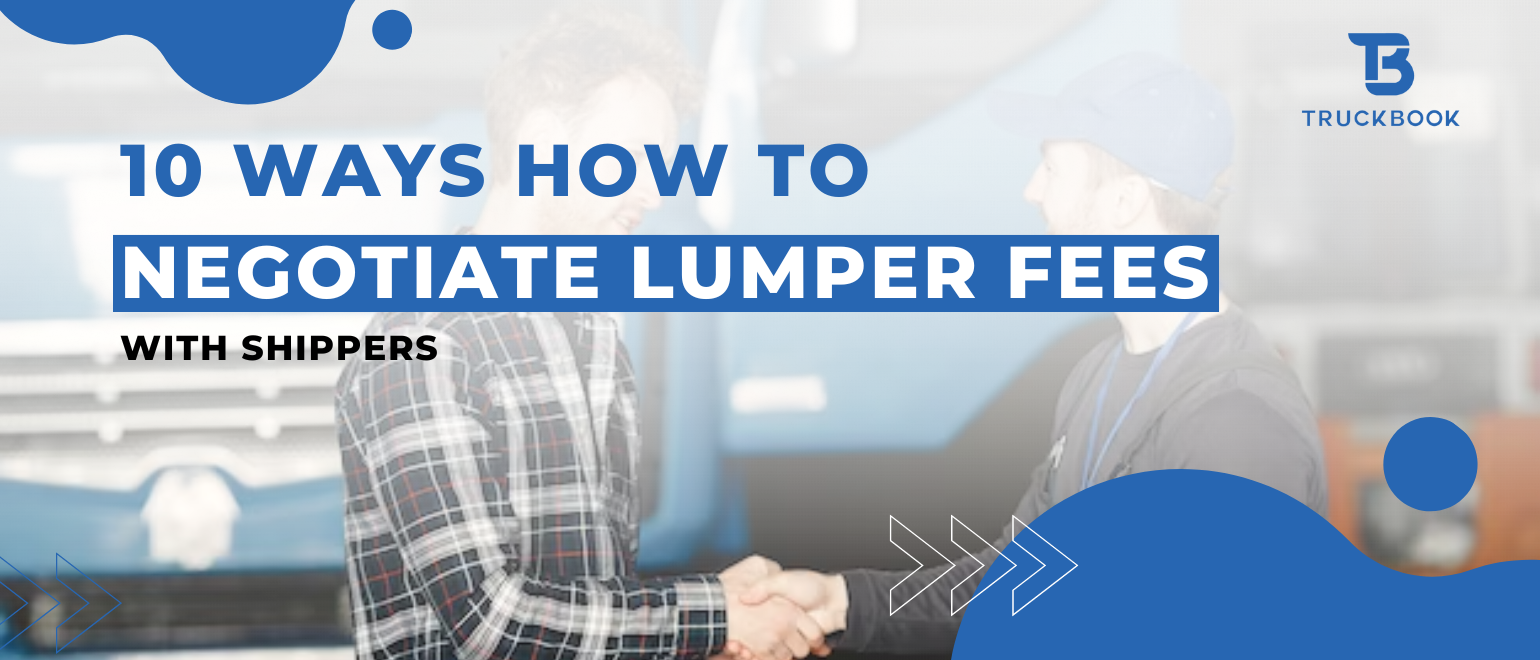As anyone in the trucking industry knows, navigating the ins and outs of the supply chain can be tough enough without having to worry about unexpected fees popping up – and that’s exactly what lumper fees can feel like, especially for truck drivers and carriers operating across the United States.
For many truck drivers and carriers in the US, navigating the world of lumper fees can be a frustrating and costly experience that adds an extra layer of complexity to an already demanding job.
Are you a truck driver or carrier tired of getting hit with unexpected lumper fees? You’re in right place – we’ve put together a list of tips and strategies to help you negotiate these fees with shippers and keep your costs under control. Let’s start with the short definition and importance of managing lumper fees to improve profitability.
What Is Lumper Fee?
In logistics, a lumper fee is a charge assessed by a third-party company for unloading a trailer or container at a warehouse or distribution center. This fee is often charged when the consignee (the recipient of the shipment) uses a third-party unloading service to unload the trailer rather than using their own employees or equipment.
Lumper fees can be challenging for logistics companies and trucking companies to manage, as they can be an unexpected expense that is not always included in the initial transportation quote. As such, logistics professionals need to be aware of lumper fees and factor them into their overall transportation costs when negotiating rates with shippers and consignees.
If you want to learn more about lumper fees and how they impact the logistics industry, be sure to check out our comprehensive guide on “Lumper Fees“.
Importance Of Managing Lumper Fees To Improve Profitability
Managing lumper fees is crucial for improving profitability in the logistics industry. Lumper fees can be an unexpected expense that can eat into your company’s profits if not managed properly. By negotiating lumper fees upfront with shippers and consignees and incorporating them into transportation costs, as a logistics company you can improve your pricing strategies and better compete in the market.
Additionally, by implementing efficient shipment loading and unloading practices and using technology to streamline the process, you can easily minimize lumper fees and maximize profitability. Overall, effective management of lumper fees is key to optimizing logistics operations and increasing profitability in the long run.
Overview Of The Main Types Of Lumper Fees And How They Are Typically Assessed
When it comes to trucking, lumper fees can refer to a combination of charges that truckers may overlook when unloading freight at a destination. There are a few different types of lumper fees that you may or may not be familiar of:
1. Standard Lumper Fee:
This is the most common type of lumper fee, and it typically ranges from $50 to $200, depending on the location and the quantity of freight that needs to be unloaded. This fee covers the cost of unloading the cargo and handling it until it can be safely delivered to the consignee.
2. Pallet Fees:
If the freight is loaded onto pallets, the third-party company may charge an additional fee to handle those pallets. This fee is typically charged per pallet and can vary depending on the size and weight of the pallets.
3. Lump Sum Fees:
Some third-party unloading companies charge a lump sum fee for their services, which may include unloading, storage, and other handling tasks. These fees can vary widely depending on the location, the amount of cargo, and the specific services provided.
4. Restocking Fee:
If the freight needs to be rearranged or re-stacked before it can be unloaded, the third-party company may charge an additional fee for this service. This fee can also vary depending on the amount of work required.
5. Extra Labor Fee:
If the cargo is particularly heavy or difficult to handle, the third-party company may charge an extra labor fee to cover the additional work required. This fee is typically added on top of the standard lumper fee.
The responsibility for paying lumper fees can vary depending on the agreement between the shipper, carrier, and receiving facility. In many cases, the carrier or trucking company is responsible for paying the lumper fees as a cost of doing business. However, some carriers may pass on these fees to the shipper, who then incorporates them into their overall shipping costs.
Top 10 Ways to Negotiate Lumper Fees with Shippers
Here are the top 10 strategies for negotiating lumper fees, including practical tips on how to prepare for negotiations, how to approach the negotiation process, and how to work collaboratively with shippers. By following these strategies, you can save money and improve your bottom line. Let’s dive in!
A. Research And Compare Lumper Fees Charged By Different Shippers
As a carrier, it’s essential to research lumper fees and compare rates to find the most cost-effective shippers. Here are some practical steps you can take to do so:
Firstly, start by determining the average lumper fee for the type of freight you typically transport. This can give you a baseline for comparison. Next, reach out to other carriers or industry contacts to get an idea of what they are paying for lumper fees. This can help you identify the range of fees that are typical for your industry.
You can also use online load boards or marketplaces to research and compare lumper fees for different shippers. Many of these platforms include tools that allow you to filter results based on lumper fees, making it easier to compare rates.
Another effective strategy is to contact shippers directly to ask about their lumper fees and negotiate rates. Before doing so, make sure to come prepared with data on typical lumper fees and rates for comparable shipments.
If you find that negotiating rates are challenging or time-consuming, consider working with a third-party logistics provider (3PL). They can help you identify the most cost-effective shippers and negotiate rates on your behalf. 3PLs often have relationships with shippers and can leverage their volume to negotiate better rates for carriers.
B. Discuss Lumper Fees With Shippers Upfront And Negotiate Fees In Advance
By negotiating fees in advance, you can better plan and budget for your shipping costs. Knowing what your lumper fees will be in advance can help you price your services more accurately and ensure that you’re covering your costs while remaining competitive in the market.
Moreover, negotiating fees in advance can also help you save money. By securing a lower rate, you can reduce your expenses and increase your profits over time.
Discussing and negotiating lumper fees in advance can also help you build stronger relationships with shippers. By demonstrating your willingness to work collaboratively and fairly, you can build trust and credibility with your business partners. This can lead to repeat business and positive word-of-mouth referrals, which can help you grow your business in the long term.
C. Build A Good Relationship With The Shipper And Show Your Value As A Carrier
Building a strong relationship with shippers is essential for carriers and trucking companies looking to establish long-term partnerships. Here are some strategies that can help:
1. Communicate Regularly:
Regular communication is crucial to building strong relationships. Make sure to keep in touch with your shippers throughout the shipping process, from pickup to delivery. Provide updates on the status of their shipment, and be responsive to their questions and concerns.
2. Be Transparent:
Be transparent about your pricing, services, and capabilities. This can help establish trust and credibility with your shippers and lead to repeat business in the long term.
3. Meet Deadlines:
Meeting deadlines is crucial to building a strong reputation in the industry. Make sure to deliver shipments on time, and be proactive in communicating any delays or issues that may arise.
4. Provide Excellent Customer Service:
Customer service is a key differentiator in the industry. Provide exceptional service to your shippers, including responding promptly to their inquiries, addressing their concerns, and meeting their requirements by going above and beyond.
5. Build Personal Relationships:
Building personal relationships with your shippers can also help establish long-term partnerships. Attend industry events, network with shippers, and take the time to get to know them professionally as well as personally.
6. Offer Value-added Services:
Offering value-added services, such as tracking and reporting, can also help differentiate your business and provide added value to your shippers.
D. Consider Using A Third-Party Logistics Provider (3PL) To Negotiate Fees On Your Behalf
Carriers and trucking companies should consider using a third-party logistics provider (3PL) to negotiate fees on their behalf for the following reasons:
1. Established Relationships with Shippers:
3PLs have existing relationships with shippers and can leverage their volume to negotiate better rates for carriers.
2. Expertise in Logistics:
3PLs have expertise in logistics and can provide valuable insights and guidance to carriers and trucking companies, including identifying cost-effective shippers and optimizing routes.
3. Improved Efficiency:
Working with a 3PL can help them stay focused on their core competencies while leaving logistics and negotiations to the experts, improving overall efficiency and productivity.
4. Greater Flexibility and Scalability:
3PLs can provide greater flexibility and scalability, allowing them to tap into additional resources and capabilities as their business grows.
E. Include Lumper Fees In Overall Negotiation Of Shipping Rates
Including lumper fees in the overall negotiation of shipping rates can help trucking companies and carriers save more on lumper fees in the following ways:
1. Better Cost Control:
By negotiating shipping rates that include lumper fees, can better control their costs and avoid unexpected expenses. This can help them better manage their budgets and increase their overall profitability.
2. Improved Efficiency:
Including lumper fees in the overall shipping rates can help avoid delays and reduce the time spent negotiating lumper fees for each shipment. This can improve overall efficiency and productivity, allowing them to handle more shipments and increase their revenue.
3. Enhanced Relationships with Shippers:
Negotiating shipping rates that include lumper fees can help build stronger relationships with their shippers. This can lead to more repeat business and better rates in the long term.
F. Ask for Reimbursement Of Lumper Fees Promptly
The party responsible for reimbursing lumper fees can vary depending on the terms of the shipping agreement. In some cases, the shipper may be responsible for paying the lumper fees, while in others, the carrier or trucking company may be responsible.
If the carrier or trucking company pays the lumper fees upfront, they may seek reimbursement from the shipper as part of the overall shipping agreement. However, if the shipper pays the lumper fees directly, they may not be responsible for reimbursing the carrier or trucking company.
In some cases, drivers pay the lumper fee and they may have to wait for a longer time to get the amount reimbursed. In that case, you should follow these steps:
1. Keep Accurate Records:
Drivers should keep accurate records of all lumper fees incurred, including the date, time, location, and amount of each fee.
2. Submit Documentation Promptly:
Once the driver has incurred a lumper fee, they should submit documentation of the fee to their carrier or company as soon as possible. This can include receipts, invoices, or other documentation that proves the fee was paid.
3. Communicate with Dispatch:
Drivers should communicate with their dispatch team to ensure that all necessary documentation has been submitted and to follow up on the status of their reimbursement.
4. Follow up Regularly:
If reimbursement is not received within a reasonable amount of time, drivers should follow up with their carrier or company regularly to ensure that the issue is resolved.
Ultimately, the responsibility for reimbursing lumper fees should be clearly defined in the shipping agreement or contract between the parties involved.
G. Leverage Technology To Manage Lumper Fees And Automate The Reimbursement Process
Shippers, carriers, and trucking companies can leverage technology to manage lumper fees and automate the reimbursement process. By using software and tools designed specifically for this purpose, they can streamline the entire process and reduce the risk of errors and delays.
Here are some of the ways technology can help include:
1. Automated Payment Processing:
Using payment processing software, shippers, carriers, and trucking companies can automatically process lumper fee payments and reimbursements, eliminating the need for manual processing.
2. Real-time Tracking and Reporting:
With tracking and reporting tools, parties involved can monitor the status of lumper fees in real time and receive notifications when payments are made or reimbursement is received.
3. Electronic Documentation and Filing:
Electronic documentation and filing systems can help parties involved to manage lumper fee receipts and other documentation more efficiently.
4. Communication and Collaboration Tools:
With communication and collaboration tools, parties involved can easily share information and collaborate on managing lumper fees.
H. Communicate Lumper Fees Often With Shippers
Communicating with shippers about lumper fees proactively can help trucking companies in several ways. By being upfront and transparent about the costs associated with lumper fees, trucking companies can build stronger relationships with shippers and increase trust and loyalty.
Some of the benefits of communicating proactively about lumper fees include:
1. Eliminating Surprises:
By discussing lumper fees upfront, trucking companies can avoid unexpected costs down the line. This can help them to better plan and manage their expenses and avoid potential cash flow issues.
2. Building Trust:
When trucking companies communicate proactively about lumper fees, they demonstrate their commitment to transparency and honesty. This can help to build trust with shippers and increase the likelihood of repeat business.
3. Reducing Disputes:
By discussing lumper fees in advance, trucking companies can reduce the likelihood of disputes or disagreements with shippers over who is responsible for paying the fees.
4. Streamlining Processes:
By working with shippers to develop a clear process for managing lumper fees, trucking companies can streamline their operations and reduce the administrative burden associated with managing these fees.
I. Track And Document Lumper Fees To Ensure Accuracy And Accountability
Importance of tracking and documenting lumper fees, there are a few reasons why this is essential:
1. Cost Control:
By tracking and documenting lumper fees, trucking companies can keep a close eye on their expenses and ensure that they are not being overcharged for unloading or loading freight. They can compare the fees charged by different third-party companies and negotiate better rates for their services.
2. Transparency:
By documenting lumper fees, trucking companies can provide clarity to their clients about the fees charged for unloading or loading freight. This helps in building trust and confidence with clients, who can be assured that they are not being overcharged.
3. Compliance:
Tracking and documenting lumper fees also helps trucking companies ensure compliance with regulations and laws governing the industry. This is particularly important in cases where there are disputes over fees charged, and the documentation can serve as evidence to support the company’s position.
4. Accountability:
Finally, tracking and documenting lumper fees helps in ensuring accountability, both for trucking companies and third-party service providers. If there are any issues or discrepancies in the fees charged, the documentation can help identify the source of the problem and hold the responsible parties accountable.
Conclusion
Negotiating lumper fees is an essential strategy for reducing costs in the trucking industry. By implementing the ten ways outlined above, you can successfully negotiate with third-party service providers, thereby reducing their overall expenses.
From establishing relationships with lumper services to developing negotiating tactics and documenting fees, these strategies can help businesses to save money on lumper fees and improve their bottom line. By taking action and implementing these tactics, you can start to see significant savings on lumper fees and enjoy the benefits of reduced costs and improved profitability. So why wait? Start implementing these strategies today and see the positive impact they can have on your business.








